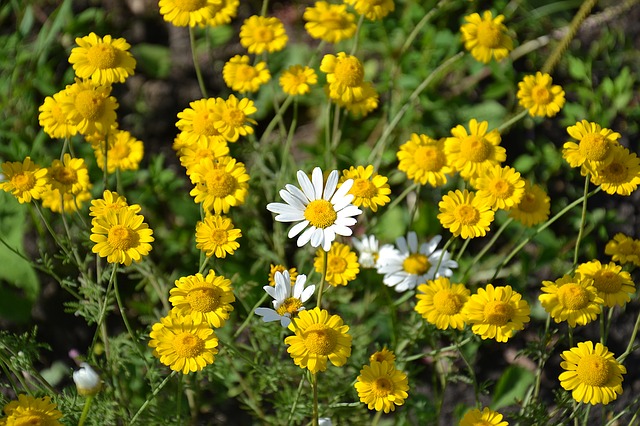 |  |  |  |  |
 |
The genus Anthemis consists of perennial or annual herbaceous plants and small semi-shrub forms. The rhizome is almost horizontal, branched, with numerous adventitious roots. From the rhizome, many grooved, cylindrical, finely hairy stems grow upwards, reaching up to 30 cm in height. The leaves are pinnately dissected or pinnately divided and sessile. Perennial species form only a rosette of leaves in the first year, and in the second year they enter the flowering stage. At the tip of the main stem and lateral shoots, inflorescences form—single flower heads that are white, rarely yellow (as in the case of Dyer’s Chamomile, Anthemis tinctoria).
The flower heads of Anthemis are quite large (2–3 cm in diameter), each consisting of 10–18 female, ligulate ray flowers and numerous bisexual tubular disc flowers arranged on a conical receptacle. The involucre of the flower head is arranged in overlapping scales, short-haired, consisting of tightly pressed linear-lanceolate bracts arranged in three rows. The ray flowers are ligulate and white in color, while the disc flowers are small, tubular, and yellow. The ray flowers lack calyx and stamens, with an inferior, single-chambered, elongated ovary. The disc flowers have an indistinct calyx shaped like a small ring above the ovary, a yellow corolla that is bell-shaped at the top with small glands. Anthemis blooms almost throughout the entire summer season. By autumn, the faded stems die off, and new flowering shoots emerge from the leaf rosettes in spring. The fruit of the plant is an achene. The plant reproduces by self-seeding; in cultivation, it can be propagated by division of the bush or rhizome. The achenes are smooth, brown, obovate, and lack a pappus.
The best-known species of the genus Anthemis include: Dyer’s Chamomile (Anthemis tinctoria), Roman Chamomile (Chamaemelum nobile), Field Mayweed (Anthemis arvensis), and Dog Mayweed (Anthemis cotula).
Harvesting Raw Material
The medicinal raw material of mayweed consists of the plant’s flowers. They are collected in dry weather during the peak flowering period (June to August). Flower heads are harvested when the ligulate flowers have not fully opened and the receptacle is still flat. At this stage, the essential oil content is high. The collected flowers are dried in the shade at a temperature not exceeding 40°C. The dried raw material is stored in paper packaging for no longer than 2 years.
Chemical Composition
The flower heads of Anthemis species contain up to 1% essential oil, sesquiterpene lactones, rubber, polyacetylenes, quercetin (a member of the vitamin P group), flavonoids (antemoside, cosmoside), wax, coumarins, and an as yet unstudied glycoside. Interestingly, luteolin derivatives predominate in the ligulate white flowers of the inflorescence, whereas apigenin derivatives are more abundant in the yellow flowers.
The essential oil components include anthemol (Anthemolum - C₁₀H₁₆O), butyl, hexyl, and amyl esters, isobutyric, angelic, and methylcrotonic acids. Additionally, the oil contains the terpene anthemen (C₁₈H₃₆) and azulene (a blue pigment). In smaller amounts, other active substances such as bisabolene, caryophyllene, cadinene, and bisabolol are present. Recently, up to 102 active components have been identified in Anthemis essential oil. A distinctive feature of this essential oil is its ability to solidify at zero degrees Celsius, while most other oils remain liquid at this temperature.
Polyacetylene compounds have been identified in the roots of Anthemis.
Pharmacological Properties
Despite the visual similarity of the flowers of Roman chamomile (Chamaemelum nobile) and German chamomile (Matricaria chamomilla), the chemical compositions of these plants differ significantly. Nevertheless, according to laboratory studies, the medicinal use of Roman chamomile is close to that of German chamomile. Anthemis exhibits antimicrobial as well as moderate fungistatic and antibacterial effects. Experiments have also demonstrated its anti-edematous and cytostatic effects (in vitro inhibition of carcinoma development). A diuretic effect of Anthemis has also been observed.
European researchers have identified a unique property of Dyer’s chamomile (Anthemis tinctoria) — the plant’s active substances are capable of normalizing the balance of vitamins and trace elements in the human body, regardless of whether there is an excess or deficiency. The hemostatic properties of Anthemis allow its use in the treatment of hemorrhagic diathesis, capillarotoxicosis, retinal hemorrhage, and other diseases involving impaired vascular permeability.
In experiments, the essential oil from fresh flower heads of Roman chamomile showed activity against gram-positive bacteria (such as Staphylococcus aureus) and inhibited the growth of dermatophytes. It has been scientifically proven that the alcoholic tincture of Anthemis herb rapidly combats protozoal infections and Escherichia coli. Animal studies showed that the alcoholic tincture reduced aggressiveness.
Renowned aromatherapist Ruth von Braunschweig from Germany demonstrated that just one drop of Anthemis essential oil applied to the solar plexus can calm the nervous system and reduce the negative effects of stress.
Use in Traditional Medicine
Possessing anti-inflammatory, carminative, antispasmodic, and other properties, Roman chamomile (Chamaemelum nobile) is used in folk medicine in many countries in the form of decoctions for stomach and intestinal ailments, colds, diathesis, atopic dermatitis, and as a choleretic and diuretic agent. Decoctions of Anthemis flowers also help with heavy uterine bleeding. Externally, the decoction is used as a mouth rinse and compresses for inflammatory processes in the oral cavity and skin lesions.
The juice of Field Mayweed (Anthemis arvensis) is taken for malignant tumors. Infusions made from crushed roots of Field Mayweed are used to enhance male potency and are also taken for epilepsy, as polyacetylene compounds have been found in the roots. Poultices made from such decoctions help relieve toothache. Anthemis species are also known for their anthelmintic properties, regardless of the plant species. Vegetable oil infused with Anthemis flower heads is used as a rubbing agent for rheumatic pains. The use of Dog Mayweed (Anthemis cotula) is practically similar to other medicinal species of the genus. The plant is used as an antispasmodic, anthelmintic, choleretic, and wound-healing agent.
